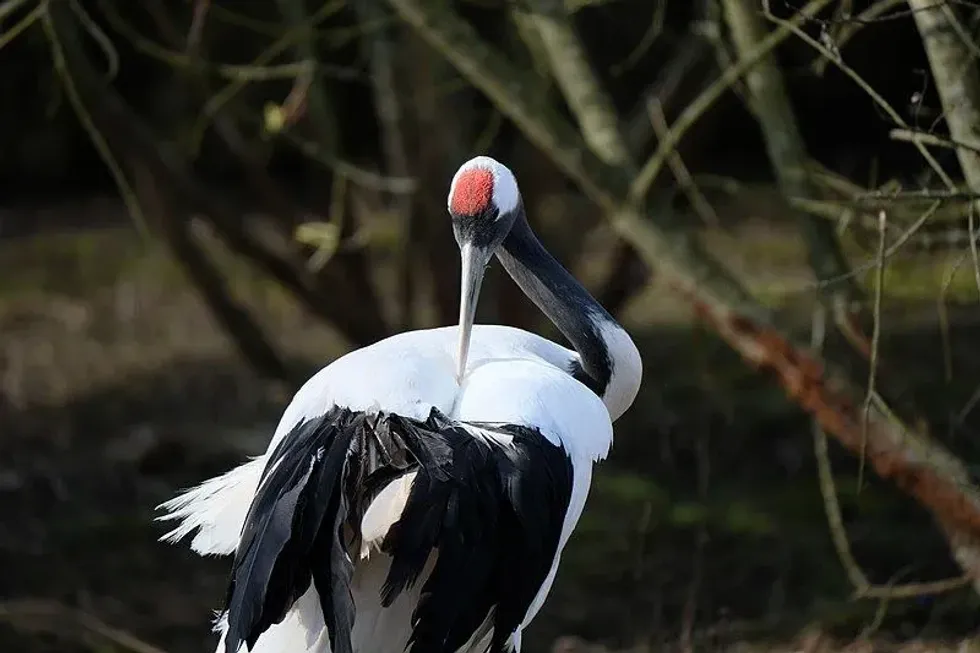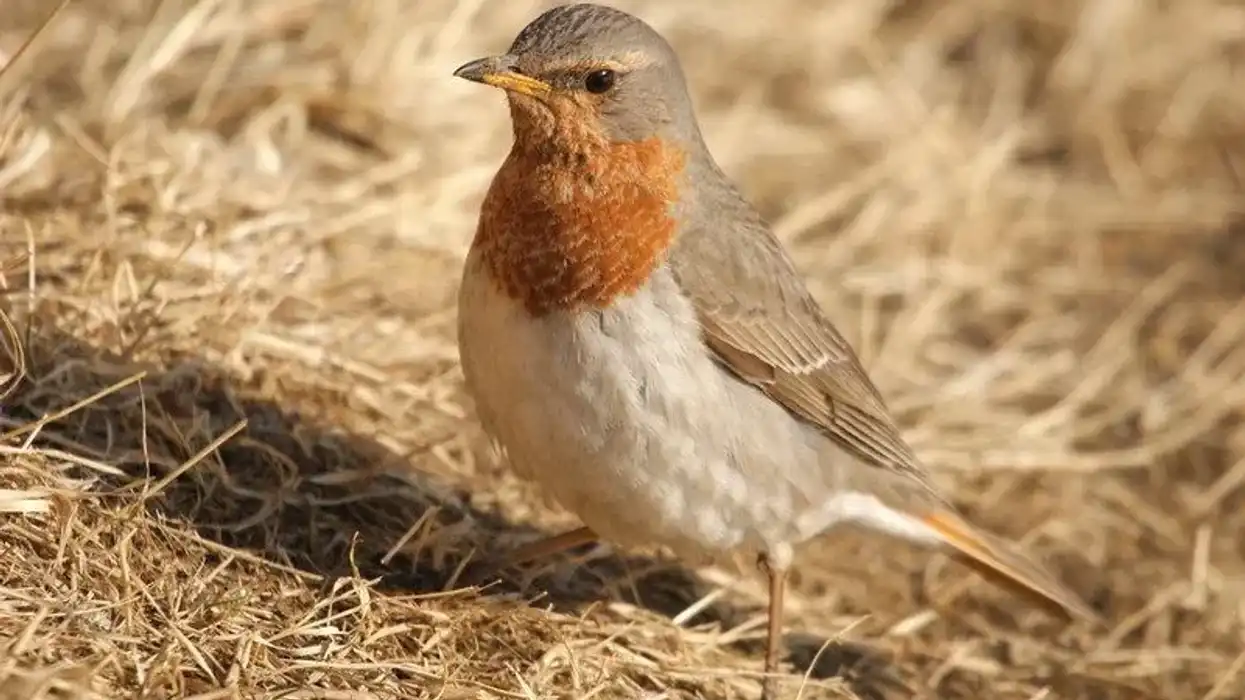Red-crowned cranes are the largest among all the cranes. They received their name because of the exposed red skin on their head. Their population is mostly found in wetlands of East Asia, especially on Hokkaido Island, and the river basin of the Amur, in Eastern Russia.
In winter, they migrate to the Korean peninsula, Japan, and China. Due to decreasing population, they are labeled as a Vulnerable species today. These birds have been hunted down for centuries.
The red-crowned crane is one of the most elegant-looking birds. They have beautiful white feathers on most of their body and black feathers on the end of their wings. These birds possess a pair of long legs and a sharp bill. They are also the heaviest ones in their group.
These cranes are monogamous and breed in summer and spring. They perform a unison call while pairing with their partner. On average, two eggs are laid per clutch. The breeding pair shares the responsibility of protecting their nest and feeding their chicks when they are born after an incubation period of 31 days.
To learn more, we have collected a set of interesting facts about red-crowned cranes for you to read. You can also learn more about fascinating wild animals and birds by reading up more articles on the swan and the goose.
Red-Crowned Crane Interesting Facts
What type of animal is a Red-Crowned crane?
A red-crowned crane (Grus japonensis) is a crane bird from the Grus genus of the Gruidae family. They are one of the largest ones in their family. They are also extremely rare. A red-crowned crane is also known as the Japanese crane and the Manchurian crane.
What class of animal does a Red-Crowned crane belong to?
Red-crowned cranes belong to the Aves class of the Animalia kingdom.
How many Red-Crowned cranes are there in the world?
According to the International Union For Conservation of Nature (IUCN) Red List, there are 1830 matured red-crowned cranes that live in our world. They became one of the rarest crane species due to the loss of habitat, triggered by industrial development, and agriculture.
Where does a Red-Crowned crane live?
Their primary range is Japan, China, and the Amur River basin, located in Eastern Russia. They are mostly migratory species, however, a tiny population of non-migratory ones also exist. The non-migratory ones are mostly spotted on the northernmost island of Japan. The Hokkaido island is home to them.
The migratory species' winter habitats are the Korean peninsula, China, and Japan. They spend the rest of the year in East Asian regions.
What is a Red-Crowned crane's habitat?
By nature, they are aquatic birds. During summertime, their favorite territory is the wetlands of East Asia, and during winter they prefer freshwater marshes of Japan and China.
One of the key differences between Red-Crowned cranes and other crane species is, thatthey prefer deep water marshes, while other cranes mostly prefer shallow water marshes.
Who do Red-Crowned cranes live with?
Red-Crowned cranes are very social birds, they fly and live in flocks. Right before the migration period, a territory's population splits into multiple flocks and prepares to fly to their winter habitats.
During the breeding season, they form a pair, prepare and protect their nest together. In early spring the breeding pair tends to maintain a minimum distance from other pairs and individuals. This is done to minimalize the fight over food.
How long does a Red-Crowned crane live?
Red-Crowned cranes lifespan ranges between 25-30 years in the wild. Depending on the diet and care given, they can live for up to 60 years in captivity!
How do they reproduce?
Red-Crowned cranes practice a monogamous mating system. They form a pair and remain together over the years. Before forming a pair, they display various courtship displays. such as, their special dance which includes leaps, bows, headbanging, dual honking, and more.
After pairing, the female selects the nesting territory, which is typically 247-1729 acres (1-7 sq. km). They prepare the nest with plant materials such as twigs, leaves, and more.
The spring and the summer is their breeding season. On average two eggs are laid. The chicks hatch out of their eggs after 31 days. The newborn chicks are around 5.3 oz (150 g).
Feeding and protecting the chicks is a shared responsibility of the breeding pair. After gaining independence, they come out of their nests and start to collect food for themselves. They gain their sexual maturity at the age of two to three years.
What is their conservation status?
With decreasing population, the International Union For Conservation of Nature (IUCN) Red List of threatened species marked the red-crowned cranes (Grus japonensis) as a Vulnerable species. Due to the loss of habitat, their population strength has decreased severely and turned into a matter of concern. They have been given protection and care by the International Crane Foundation.
Red-Crowned Crane Fun Facts
What do they look like?

Red-crowned cranes are one of the most beautiful, elegant, and largest species of cranes. They have long legs, large wings, and a long beak. The key difference between male and females are males have a comparatively larger body and black feathers on their neck and throat. Females have pearly gray feathers on the same areas.
How cute are they?
Red-crowned cranes are elegant, gorgeous, and cute. Their beautifully pearl white feathered body with black highlights on their wings makes them look stunning.
How do they communicate?
Like other cranes, they communicate with each other by making various calls and body movements. They have a loud and clear call. The chicks can make more intense calls, which they utilize in difficult situations.
How big is a Red-Crowned crane?
Red-crowned cranes are typically 47.2-59 in (1.2-1.5 m) in length, with an average wingspan of 94.4 in (2.4 m). They are slightly shorter in size than sarus cranes.
How fast can a Red-Crowned crane fly?
They can fly at a speed of 25 mph (40.2 kph). They fly in flocks during migration season. They, along with the rest of the crane family, are one of the tallest flying birds in our world.
How much does a crane weigh?
Red-crowned cranes are the heaviest ones in their group. The average weight of red-crowned cranes is 18.7-20.9 lb (8.5-9.5 kg). The heaviest known red-crowned crane was 33 lb (15 kg).
What are their male and female names of the species?
Female cranes are known as hens, and males are known as cocks.
What would you call a baby Red-Crowned crane?
Baby red-crowned cranes are called chicks.
What do they eat?
They are omnivorous birds. The primary diet of their population includes snails, insects, small aquatic invertebrates, various small fish, amphibians, and small rodents. Their vegetarian diet includes heath, berries, corn, and acorns. Their winter diet includes agricultural waste as well.
In the wild, they look for food in water marshes. The captives are dependent on humans for food. They feed on cereals and fish. Their long and sharp beak makes it easier for them to catch prey.
Are they dangerous?
They are not dangerous birds. Instances of cranes attacking humans are rare. However, if threatened they display various aggressive behaviors to protect their nest or feeding area and family.
Would they make a good pet?
Red-crowned cranes are wild birds and their population lives in certain areas only. The Migratory Bird Treaty Act prohibits any action regarding owning, selling, purchasing, and hunting migratory birds. For centuries they have been captured and killed mercilessly, and as a result of which, they are a Vulnerable species today.
Did You Know...
Preening is an essential part of a waterbirds' life. Red-crowned cranes have the uropygial gland on the base of their tail. This gland ejects an oily substance, to coat their feathers. This process gives their wings a protective waterproof coating.
What does the Red-Crowned crane symbolize?
The red-crowned crane is hailed as 'Durumi' and 'Hak' in South Korea. South Koreans consider them as a symbol of longevity, peace, and purity.
Japan considers them as mystical and holy birds. In Japan, they are a symbol of prosperity, good health, love, and fidelity in marriage.
What sound does a red-crowned crane make?
Red-crowned cranes can make loud, high-pitched yet subtle calls. A chick has more of a harsh note to his call and a mild and gentle call when they receive affection. During the breeding season, they also perform unison calls.
Here at Kidadl, we have carefully created lots of interesting family-friendly animal facts for everyone to discover! Learn more about some other birds including the golden masked owl and the quetzal.
You can even occupy yourself at home by drawing one of our Red crowned crane coloring pages.










